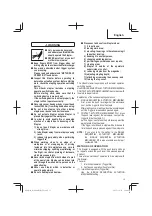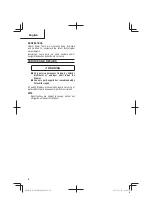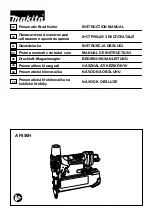
(3) Be careful of double
fi
re and being hit by the
Stapler due to spring back (“recoil”).
After driving
a staple, the Stapler may recoil causing it to move
away from the work surface.
To reduce risk of injury always manage recoil by:
1) always maintaining control of the Stapler.
2) allowing recoil to move the Stapler away from
work surface.
3) not resisting recoil such that the Stapler will be
forced back into the work surface. In “CONTACT
ACTUATION MECHANISM”, if push lever is
allowed to re-contact work surface before the
trigger is released, an unintended discharge of a
staple will occur. In order to avoid this undesirable
double
fi
re,
○
Intermittent operation (Trigger
fi
re)
1
Set the switching device to SINGLE
SEQUENTIAL ACTUATION MECHANISM.
2
Pull the trigger rapidly and
fi
rmly.
○
Continuous operation (Push lever
fi
re)
1
Set the switching device to CONTACT
ACTUATION MECHANISM.
2
Do not press the Stapler against the wood with
excessive force.
3
Separate the Stapler from the wood as it
recoils after stapling
4) keeping face and body parts away from the
Stapler.
(4) Never Use NON relieving coupler on Stapler.
If a non relieving coupler is used on the Stapler,
the Stapler can remain charged with air after
disconnecting and thus will be able to drive a fastener
even after disconnecting. The Stapler and air hose
must have a hose coupling such that all pressure is
removed from the Stapler when the coupling joint is
disconnected.
(5) Check Push Lever before use.
Make sure the
Push Lever operates properly, and is not inoperable,
disconnected, or altered. (The Push Lever may be
called “Safety”.) Never use the Stapler unless the
Push Lever is operating properly, otherwise the
Stapler could drive a fastener unexpectedly. Do not
tamper with or remove the Push Lever, or otherwise
cause the Push Lever to become inoperable.
(6) Keep all screws and covers tightly in place.
Keep
all screws and covers tightly mounted.
Check their condition periodically. Never use the
Stapler if parts are missing or damaged.
(7) Do not load fasteners with Trigger or Push Lever
depressed.
When loading fasteners into the Stapler
or when connecting the air hose,
1) do not depress the Trigger;
2) do not depress the Push Lever; and
3) keep the Stapler pointed downward.
(8) Keep hands and body away from
fi
ring head
during use.
Never place your hands or feet closer
than 8 inches (200 mm) from the
fi
ring head. A
serious injury can result if the fasteners are de
fl
ected
by the workpiece, or are driven away from the point of
entry.
(9) When working close to an edge of a workpiece
or at steep angles, or driving fasteners into
thin workpiece use care to minimize chipping,
splitting or splintering, or free
fl
ight, ricochet or
piercing of fasteners, which may cause injury.
(10) Never drive fasteners from both sides of a wall
at the same time.
The fasteners can be driven into
and through the wall and hit a person on the opposite
side.
(11) Use extra caution when driving the Stapler into
existing walls or other blind areas to prevent
contact with hidden objects or persons on other
side (eg., wires, pipes).
(12) Check for live wires.
Avoid the risk of severe
electrical shock by checking for live electrical wires
that may be hidden by walls,
fl
oors or ceilings. Turn
o
ff
the breaker switch to ensure there are no live
wires.
(13) Do not lift, pull or lower the Stapler by the hose.
(14) Do not disconnect air hose from Stapler with
fi
nger on Trigger.
The Stapler can
fi
re when
reconnected to An air supply.
(15) Handle Stapler correctly.
Operate the Stapler
according to this Manual. Never allow the Stapler to
be operated by children, individuals unfamiliar with its
operation or unauthorized personnel.
(16) Never use Stapler for applications other than
those speci
fi
ed in this manual.
(17) Never modify or alter a Stapler.
Doing so may
cause it to malfunction and personal injuries may
result.
SAFETY
— Continued
WARNING
7
English
000Book̲N3804AB3(S)̲US.indb 7
000Book̲N3804AB3(S)̲US.indb 7
2015/12/25 16:49:54
2015/12/25 16:49:54








































